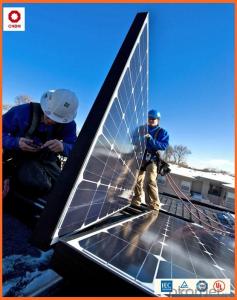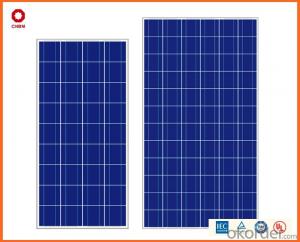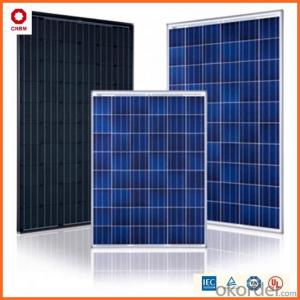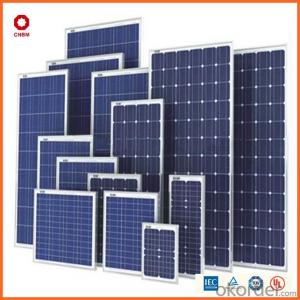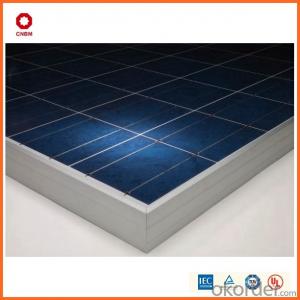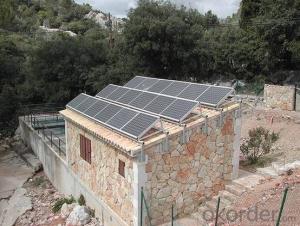Stock 305w Poly Solar Panel 0.46/W A Grade Good Solar Panel on Sale
- Loading Port:
- China main port
- Payment Terms:
- TT OR LC
- Min Order Qty:
- 1 watt
- Supply Capability:
- 10000000 watt/month
OKorder Service Pledge
OKorder Financial Service
You Might Also Like
Item specifice
Hot Sale !!! Quality and Safety of 245w-320w Poly Solar Panel
1. Rigorous quality control meets the highest international standards.
2. High-transmissivity low-iron tempered glass, strong aluminium frame.
3. Using UV-resistant silicon.
4. IS09001/14001/CE/TUV/UL
Warranties of 245w-320w Poly Solar Panel
1. 10 years limited product warranty
2. 15 years at 90% of the minimal rated power output
3. 25 years at 80% of the minimal rated power output
Technical date of 245w-320w Poly Solar Panel
Specification
Characteristics of Poly solar panels CNBM (245-320W) | |||||
Max Power Voltage Vmp(V) | 30.3 | 30.8 | 31.1 | 31.4 | 31.85 |
Max Power Current Imp(A) | 7.60 | 7.64 | 7.73 | 7.81 | 7.85 |
Open Circuit Voltage Voc(V) | 36.1 | 36.6 | 37 | 37.3 | 37.68 |
Short Circuit Current Isc(A) | 8.50 | 8.55 | 8.65 | 8.75 | 8.85 |
Max Power Pm(W) | 230W | 235W | 240W | 245W | 250W |
Temperature Coefficient of Cells Poly solar panels CNBM (245-320W) | |
NOCT | 45 ± 2 |
Temperature Coeffucients of Isc | 0.0492 |
Temperature Coeffucients of Voc ( | -0.3374 |
Temperature Coeffucients of Voc | -0.4677 |
Mechanical Data of Poly solar panels CNBM (245-320W) | |
Dimension | 1638 × 982 × 40 mm |
Weight | 19.5 kg |
No. of Cells and Connections | 60 (6 ×10) |
Tolerance | 0 ~ + 5 W |
Cell | Monocrystalline Cell 156 × 156 mm |
Packing | 624 Pcs/40ft(H) Container |
Limits of Poly solar panels CNBM (245-320W) | |
Operating Temperature | -4 0to +85 |
Storage Temperature | -40to +85 |
Max System Voltage | 1000VDC(IEC) / 600VDC(UL) |
Features of our products:
• High conversion efficiency mono/poly-crystalline amorphous silicon solar cells
• Modules incorporate high performance bypass diodes to minimize the power drop caused by shading
• High transmittance, low-iron tempered glass
• High performance EVA encapsulant to prevent destroying and water.
• AI frame: without screw, corner connection. 8 holes on the frame can be installed easily
• Good performance of preventing from atrocious weather such as wind and hails
• Certifications: CE IEC TUV VDE UL, Class I
• 10 years 90% power output warranty

- Q:Can solar energy systems be installed on airports or transportation hubs?
- Yes, solar energy systems can be installed on airports or transportation hubs. In fact, many airports and transportation hubs around the world have already embraced solar energy as a sustainable and cost-effective solution. These systems can be installed on rooftops, parking structures, or open spaces within the premises, providing clean and renewable energy to power various operations and reduce carbon emissions.
- Q:Can solar energy systems be used in remote locations?
- Yes, solar energy systems can be used in remote locations. Solar panels can be installed in areas with no access to electricity grids, providing a reliable source of clean energy. The abundant sunlight in remote locations makes solar power an efficient and sustainable solution for meeting energy needs. Additionally, advancements in battery storage technology allow solar energy to be stored and used during nighttime or cloudy periods, further enhancing its suitability for remote areas.
- Q:Can solar energy systems be used in countries with low sunlight availability?
- Solar energy systems can still be employed in countries with limited sunlight. Although these systems depend on sunlight to produce electricity, technological advancements now enable the efficient capture and utilization of even small amounts of sunlight. Moreover, solar energy systems can be engineered to integrate other renewable energy sources like wind or hydroelectric power to compensate for the scarcity of sunlight. Furthermore, energy storage systems like batteries can store surplus energy during periods of low sunlight and release it as required. Consequently, solar energy systems remain a feasible and sustainable choice for electricity generation even in countries with insufficient sunlight.
- Q:Can solar energy systems be installed on mobile homes or RVs?
- Yes, solar energy systems can be installed on mobile homes or RVs. With advancements in technology, portable solar panels and battery systems have become more compact and efficient, making it possible to harness solar energy for these mobile structures. This allows for greater energy independence and the ability to power various appliances and devices while on the move.
- Q:How does the color of solar panels affect energy production?
- The color of solar panels does not significantly affect energy production. The efficiency and power output of solar panels are determined by their material and design, not their color. However, darker colors may absorb more heat, which can slightly increase the operating temperature of the panels and decrease their efficiency.
- Q:Can a solar energy system power an entire home or business?
- Yes, a properly designed and sized solar energy system can power an entire home or business. The system should be tailored to the energy needs of the property, taking into account factors such as energy consumption, available roof or ground space for solar panels, and geographic location to ensure sufficient power generation. With advanced technology and efficient solar panels, it is possible to achieve energy independence and offset the majority, if not all, of the electricity requirements with solar energy.
- Q:Are there any risks of electrical hazards during installation or maintenance of solar energy systems?
- Yes, there are risks of electrical hazards during the installation or maintenance of solar energy systems. Solar energy systems involve working with high-voltage DC (direct current) electricity, which can pose dangers if not handled properly. Some of the potential risks include: 1. Electrocution: Solar panels generate electricity, and if not isolated or disconnected properly, there is a risk of electrocution for individuals working on the system. 2. Fire Hazards: Faulty wiring, loose connections, or improper installation can lead to electrical arcs and sparks, which can ignite a fire if proper precautions are not taken. 3. Falls and Injuries: Solar panels are typically installed on rooftops, which may involve climbing ladders, working at heights, and handling heavy equipment. If not done with caution, it can result in slips, falls, or injuries. 4. Arc Flash: When working on live electrical equipment, there is a risk of arc flash, which is a sudden release of energy that can cause severe burns, hearing damage, and even death. 5. Environmental Risks: While not directly related to electrical hazards, it is essential to consider potential environmental risks during the installation of solar energy systems. For instance, improper disposal of hazardous materials used in solar panels, such as lead, cadmium, or other toxic substances, can harm the environment if not handled correctly. To mitigate these risks, it is crucial to follow proper safety protocols and guidelines during the installation and maintenance of solar energy systems. This includes wearing personal protective equipment (PPE), ensuring proper grounding and isolation procedures, using insulated tools, and following all local electrical codes and regulations. It is also recommended to hire trained and certified professionals for the installation and maintenance to minimize the risks associated with electrical hazards.
- Q:Can solar energy systems be used in rural areas?
- Yes, solar energy systems can definitely be used in rural areas. In fact, solar power is particularly well-suited for rural areas due to its decentralization and independence from the electrical grid. Rural areas often lack access to reliable and affordable electricity, making solar energy an attractive option. Solar panels can be installed on rooftops or on open land, providing a sustainable and renewable source of energy. Additionally, solar energy systems can be combined with energy storage solutions, such as batteries, to ensure a continuous power supply even during periods of low sunlight. This can be particularly beneficial for rural areas that may experience frequent power outages or have limited access to the electrical grid. Moreover, solar energy systems have a low maintenance requirement, making them suitable for remote locations where regular maintenance services may not be readily available. Overall, solar energy is a viable and increasingly popular solution for powering rural areas, offering numerous benefits such as reduced dependence on fossil fuels, cost savings, and environmental sustainability.
- Q:Can solar energy systems be used in cold storage facilities?
- Yes, solar energy systems can be used in cold storage facilities. Solar panels can generate electricity to power the refrigeration systems required for cold storage. However, it is important to design the system with proper insulation and backup power options to ensure continuous operation during periods of low sunlight or high energy demand.
- Q:Are solar energy systems expensive to install?
- Solar energy systems can be initially expensive to install, but they offer long-term cost savings and potential return on investment through reduced energy bills and government incentives.
1. Manufacturer Overview |
|
|---|---|
| Location | |
| Year Established | |
| Annual Output Value | |
| Main Markets | |
| Company Certifications | |
2. Manufacturer Certificates |
|
|---|---|
| a) Certification Name | |
| Range | |
| Reference | |
| Validity Period | |
3. Manufacturer Capability |
|
|---|---|
| a)Trade Capacity | |
| Nearest Port | |
| Export Percentage | |
| No.of Employees in Trade Department | |
| Language Spoken: | |
| b)Factory Information | |
| Factory Size: | |
| No. of Production Lines | |
| Contract Manufacturing | |
| Product Price Range | |
Send your message to us
Stock 305w Poly Solar Panel 0.46/W A Grade Good Solar Panel on Sale
- Loading Port:
- China main port
- Payment Terms:
- TT OR LC
- Min Order Qty:
- 1 watt
- Supply Capability:
- 10000000 watt/month
OKorder Service Pledge
OKorder Financial Service
Similar products
New products
Hot products
Hot Searches
Related keywords
